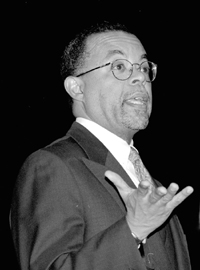The University Record, January 24, 2000 By Mary Jo Frank
Office of Communications

“We have to get African American children on the Internet,” declared Henry Louis Gates Jr., director of Harvard University’s W.E.B. Du Bois Institute for Afro-American Research and keynote speaker at the University’s Martin Luther King Jr. Symposium.
Gates, also the W.E.B. Du Bois Professor of Humanities at Harvard, announced plans to establish after-school programs to teach children about computers and Black history. The goal: to overcome inequities resulting from what he called “cyber segregation and the digital divide.” The Martin Luther King schools, to be owned and operated by Blacks and housed primarily in churches, would be similar to Hebrew school, Gates explained.
Not unlike automakers who thrilled Cobo Hall crowds with their concept cars, Gates wowed a packed Hill Auditorium as he used a laptop computer to demonstrate on a large screen the splashy multi-media vehicle he hopes will draw children to the information highway—a CD-ROM version of an encyclopedia about Africa and its diaspora in the Americas, Asia and Europe.
“Encarta Africana” makes available thousands of pieces of film and audio footage, including historic moments in the Civil Rights Movement, track star Jesse Owens at the 1936 Olympics, the complete text of the Library of Black America from 1773 to 1919, musical performances by Aretha Franklin and Miles Davis, and even a giraffe giving birth. It offers virtual tours of art galleries, cities and important historical sites. An interactive map of Africa features flora and fauna, languages, and culture by country, including an audio clip of each country’s national anthem.
The CD-ROM grew from a pact made 25 years ago by Gates and two colleagues, an African prince and Gates’ mentor, Nigerian dramatist and Nobel Prize-winner Wole Soyinka, to create an encyclopedia about Africa and its people. They were inspired by Du Bois, who had dreamed of publishing a Black Encyclopedia Britannica.
Du Bois, the first African American to earn a doctorate from Harvard, co-founded the National Negro Committee (forerunner to the National Association for the Advancement of Colored People) in 1910 and edited the NAACP magazine, The Crisis, until he was fired in 1932.
Twice, in 1910 and again from 1932 to 1946, Du Bois labored unsuccessfully to raise $250,000 to publish a Black encyclopedia. Gates also had difficulty raising money for the CD-ROM version. After receiving 25 rejection letters, Microsoft Corp. and the Carnegie Foundation agreed to provide the $2 million needed, with the stipulation that it be completed in 18 months.
Before Gates launched into his lively, anecdote-filled lecture, the symposium program was interrupted briefly by nine men and women who identified themselves as a “coalition of students of color.”
Mounting the stage and taking over the microphone, a spokeswoman read a statement charging that U-M’s practices are inconsistent with its rhetoric on the importance of diversity. Referring to the symposium’s theme, “MLK 2K: Shattering Barriers, Transcending Borders,” the students said the U-M is failing to transcend borders.
Shortcomings the students cited included recruitment and retention of faculty of color; declining numbers of students of color; understaffing and underfunding of the Office of Student Affairs; too few people of color in administrative positions; and acceptance of the existence of Michigamua, a society whose practices, the students charged, demean Native Americans. After reading the statement, the protesters and about 15 others quietly marched out of Hill Auditorium amid some cheers of support from the audience.
Acknowledging that the students’ actions “took a lot of courage,” Gates said that he would like to see more Harvard students speaking out. He also commended the University and President Lee C. Bollinger for not capitulating to legal challenges to affirmative action.
“I will go to my grave as an ardent and passionate defender of affirmative action. I never would have escaped West Piedmont, Virginia, without affirmative action,” Gates said.
When he enrolled at Yale University in 1969, Gates recalled, he was one of 96 Black first-year students. Prior to the late 1960s, Yale used a strict quota system, graduating six Blacks annually. The few Blacks admitted were sons of doctors, lawyers and other professionals, or were connected to powerful white people. Gates would not have met the earlier admissions criteria for Blacks, he said, because he didn’t have the income or connections. His father worked two jobs, as a laborer at a paper mill during the day and as a janitor at a telephone company at night.
After graduating summa cum laude from Yale in 1973, Gates became the first African American to earn a doctorate at Cambridge University. The winner of a MacArthur Foundation “genius” grant, Gates is a staff writer for The New Yorker, general editor of the Norton Anthology of African American Literature, and author of several acclaimed books, including The Signifying Monkey: Towards a Theory of Afro-American Literary Criticism, which received the American Book Award, and Colored People: A Memoir. He was identified by Time magazine in 1997 as one of the 25 most influential Americans.

